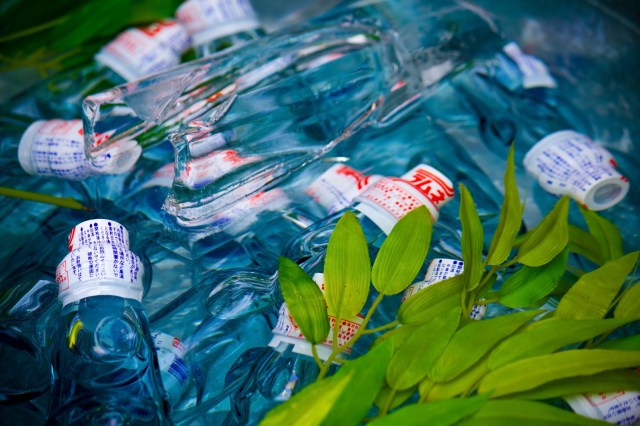
Not the ramune!
Though ramune can be enjoyed year-round, the Japanese soft drink is most associated with hot summer days. This drink’s appeal point isn’t just its sweet, carbonated goodness, but the iconic glass bottles it’s sold in as well as the translucent marble lying within its neck, making it a fun and charming addition to any picnic or afternoon snack break. However, as we enter our second summer of the COVID-19 pandemic, ramune’s future is facing a bleak outlook as COVID-19 forces manufacturing facilities to shutter and causes plummeting sales.
▼ Will summer in Japan ever be the same if ramune of all things disappears?
Created in the late 1800s by a Scottish pharmacist in Kobe, ramune has experienced much love and positive reception, becoming a hit in Japan and even abroad. At one point, ramune production facilities were numbered at 2,300 in Japan at the peak of its popularity, though unfortunately such golden days have not continued into the present. Before the pandemic, only 37 companies remained, and with four closing down in 2020, the number of ramune manufacturers has fallen to 33 total.
In terms of sales, they’ve been dropping across the board for this iconic soda. Ramune sold in glass bottles was totaled at 1,319,000 units in 2019 whereas 2020 sales showed a 35 percent decrease with only 855,000 bottles sold. For ramune sold in plastic receptacles instead, the drop in sales is even more steep: 1,160,000 bottles sold in 2019 vs 279,000 bottles sold in 2020, or a 76 percent decline. But what has led to this fall specifically? COVID-19 has hurt a variety of different industries, but what’s with ramune’s situation?
The main reason the ramune industry has taken a financial blow is due to the lack of festivities and events where ramune is commonly sold, such as summer festivals, according to the National Ramune Association. Secondly, izayaka pubs usually generate a lot of revenue for ramune sellers, since it’s also used in cocktails, but with business hours shortened by prefectural state of emergency decrees, demand from pubs has dropped too. Lastly, tourist spots also sell a good amount of ramune, but Japan is still closed to international tourists and many locals have been postponing domestic travel plans.
With Japan facing its fourth wave of infections and growing unease of the country’s slow vaccine rollout, it’s fair to say many ramune producers are not optimistic that sales will pick up this summer, especially as several Japanese beverage and soft drink companies have already withdrawn their membership from the National Ramune Association.
▼ Your typical Japanese summer festival scene, pre-COVID-19.
However, despite these troubles, there are exceptions, and some producers have ended up sending more shipments of ramune abroad than within Japan. One such producer in this situation, Kimura Drink, has given an insightful comment on this phenomenon as well as ramune drinking trends across the Pacific Ocean in particular:
“Our company currently exports ramune to 40 different countries, with the United States being our number one buyer. However, compared to Japan where ramune is widely available in supermarkets and convenience stores, buying habits from the US show consumers stocking up on ramune in their households regardless if they live or don’t live in an urban area [where products from Japan are more accessible.] It seems ramune in glass bottles, which have a longer shelf life, are rather popular. So while in Japan we aim to sell more ramune when the weather becomes hotter and summer festivities are in full swing, in the US we offer ramune as a refreshing, everyday drink.”
▼ But let’s be real: who doesn’t love a ramune fresh outta the ice cooler on a sunny day?
While only five manufacturers out of 33 selling ramune overseas, perhaps more exports within our globalized world is what we need to ensure future generations can enjoy the famous and delicious Japanese soda. Otherwise, it may be time to get extra inventive, such as incorporating ramune into milkshakes and crab meat.
Source: Daily Shincho via Hachima Kiko
Top image: Pakutaso
Insert images: Pakutaso (1, 2, 3, 4)
● Want to hear about SoraNews24’s latest articles as soon as they’re published? Follow us on Facebook and Twitter!
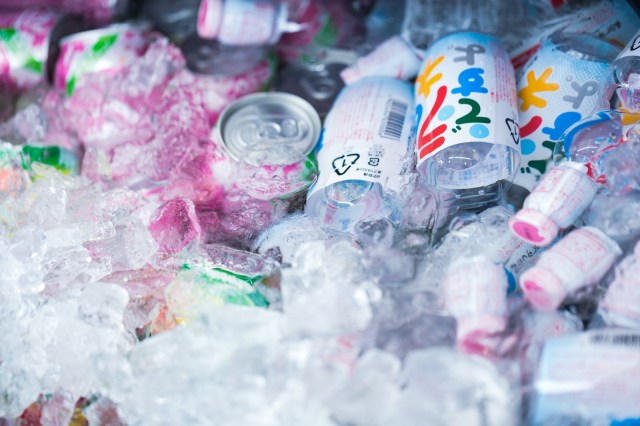
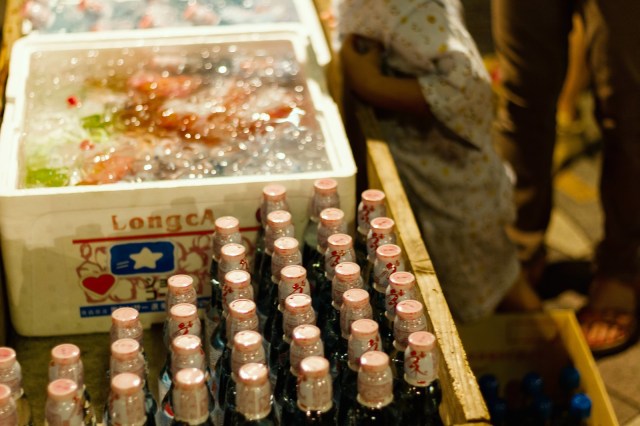
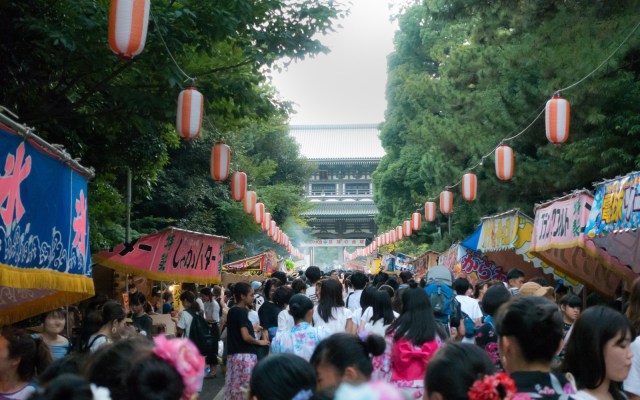
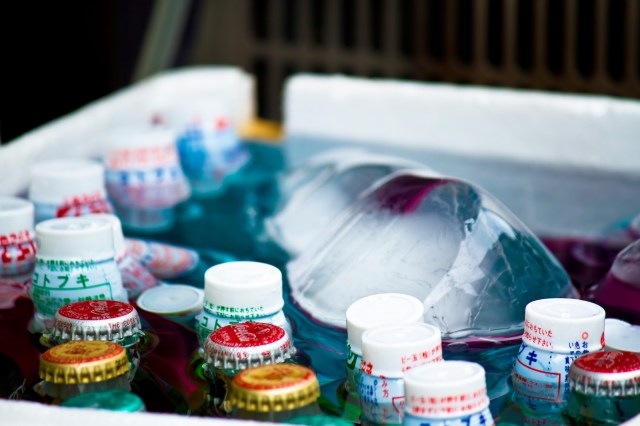
 McDonald’s captures the sweet flavour of Japan with new Ramune milkshake
McDonald’s captures the sweet flavour of Japan with new Ramune milkshake Japanese sweets lovers soon to be in their blue heaven with beautiful aqua-color Ramune dorayaki
Japanese sweets lovers soon to be in their blue heaven with beautiful aqua-color Ramune dorayaki McDonald’s adds Doraemon exclusives to its menu in Japan【Taste test】
McDonald’s adds Doraemon exclusives to its menu in Japan【Taste test】 Japan’s Sparkling Macarons come packed with candies that burst in your mouth, not in your hand
Japan’s Sparkling Macarons come packed with candies that burst in your mouth, not in your hand Thomas the Tank Engine in Ramune candy form is actually pretty terrifying 【Pics】
Thomas the Tank Engine in Ramune candy form is actually pretty terrifying 【Pics】 Japan’s new difficult-to-drink-from beer glass protects your liver, but it’s a brutal experience
Japan’s new difficult-to-drink-from beer glass protects your liver, but it’s a brutal experience How to order snacks on a Shinkansen bullet train in Japan
How to order snacks on a Shinkansen bullet train in Japan Caffeinated ramen for gamers that you can eat with one hand going on sale in Japan
Caffeinated ramen for gamers that you can eat with one hand going on sale in Japan Hello, cosmetics! Clinique teams up with Hello Kitty this summer for first-time collaboration
Hello, cosmetics! Clinique teams up with Hello Kitty this summer for first-time collaboration Demon Slayer: Kimetsu no Yaiba gets new roller coaster attractions and food at Universal Studios Japan
Demon Slayer: Kimetsu no Yaiba gets new roller coaster attractions and food at Universal Studios Japan To combat declining birth rate, Japan to begin offering “Breeding Visas” to foreigners
To combat declining birth rate, Japan to begin offering “Breeding Visas” to foreigners High-fashion Totoro cuddle purse is like an elegant stroll in the forest【Photos】
High-fashion Totoro cuddle purse is like an elegant stroll in the forest【Photos】 Gigantic new anime store opening soon in Tokyo, and here’s a sneak-peek【Photos】
Gigantic new anime store opening soon in Tokyo, and here’s a sneak-peek【Photos】 We investigate the newly released film revival of Hayao Miyazaki’s Sherlock Hound
We investigate the newly released film revival of Hayao Miyazaki’s Sherlock Hound Doraemon found buried at sea as scene from 1993 anime becomes real life【Photos】
Doraemon found buried at sea as scene from 1993 anime becomes real life【Photos】 Nintendo history you can feel – Super NES, N64, and GameCube controllers become capsule toys
Nintendo history you can feel – Super NES, N64, and GameCube controllers become capsule toys “The most Delicious Cup Noodle in history” – Japan’s French Cup Noodle wins our heart【Taste test】
“The most Delicious Cup Noodle in history” – Japan’s French Cup Noodle wins our heart【Taste test】 Starbucks releases a cute Frappuccino and Unicorn Cake…but not in Japan
Starbucks releases a cute Frappuccino and Unicorn Cake…but not in Japan Kyoto Tower mascot termination reveals dark side behind cute Japanese characters
Kyoto Tower mascot termination reveals dark side behind cute Japanese characters McDonald’s Japan’s Soft Twist Tower: A phantom ice cream only sold at select branches
McDonald’s Japan’s Soft Twist Tower: A phantom ice cream only sold at select branches Yabai Ramen: What makes this Japanese ramen so dangerous?
Yabai Ramen: What makes this Japanese ramen so dangerous? Finally! Nintendo Japan expands Switch 8-bit controller sales to everybody, Online member or not
Finally! Nintendo Japan expands Switch 8-bit controller sales to everybody, Online member or not Japanese government wants to build luxury resorts in all national parks for foreign tourists
Japanese government wants to build luxury resorts in all national parks for foreign tourists 10 things you should buy at 7-Eleven in Japan
10 things you should buy at 7-Eleven in Japan Studio Ghibli releases anime heroine cosplay dresses that are super comfy to wear
Studio Ghibli releases anime heroine cosplay dresses that are super comfy to wear Woman charged for driving suitcase without a license in Osaka
Woman charged for driving suitcase without a license in Osaka Studio Ghibli unveils My Neighbour Totoro miniature house model
Studio Ghibli unveils My Neighbour Totoro miniature house model Kyoto experiencing problems with foreign tourists not paying for bus fares, but not on purpose
Kyoto experiencing problems with foreign tourists not paying for bus fares, but not on purpose Fighting mild hunger with a Japanese soda that turns into jelly in the stomach【Taste test】
Fighting mild hunger with a Japanese soda that turns into jelly in the stomach【Taste test】 Studio Ghibli’s Howl’s Moving Castle tapestry unveiled in Japan for first time
Studio Ghibli’s Howl’s Moving Castle tapestry unveiled in Japan for first time McDonald’s new Happy Meals offer up cute and practical Sanrio lifestyle goods
McDonald’s new Happy Meals offer up cute and practical Sanrio lifestyle goods Sales of Japan’s most convenient train ticket/shopping payment cards suspended indefinitely
Sales of Japan’s most convenient train ticket/shopping payment cards suspended indefinitely Sold-out Studio Ghibli desktop humidifiers are back so Totoro can help you through the dry season
Sold-out Studio Ghibli desktop humidifiers are back so Totoro can help you through the dry season Japanese government to make first change to romanization spelling rules since the 1950s
Japanese government to make first change to romanization spelling rules since the 1950s Foreigner’s request for help in Tokyo makes us sad for the state of society
Foreigner’s request for help in Tokyo makes us sad for the state of society Ghibli founders Toshio Suzuki and Hayao Miyazaki contribute to Japanese whisky Totoro label design
Ghibli founders Toshio Suzuki and Hayao Miyazaki contribute to Japanese whisky Totoro label design Tokyo’s most famous Starbucks is closed
Tokyo’s most famous Starbucks is closed Princesses, fruits, and blacksmiths: Study reveals the 30 most unusual family names in Japan
Princesses, fruits, and blacksmiths: Study reveals the 30 most unusual family names in Japan McDo…raemon! McDonald’s Japan offering Doraemon Shake and pie for festival season
McDo…raemon! McDonald’s Japan offering Doraemon Shake and pie for festival season Cola-flavored mochi sweets are half Japanese tradition, half jiggly Pop Rock
Cola-flavored mochi sweets are half Japanese tradition, half jiggly Pop Rock We eat Chinese food inspired by Demae Itcho instant ramen to celebrate its 55-year anniversary
We eat Chinese food inspired by Demae Itcho instant ramen to celebrate its 55-year anniversary The fantastic feast of festival food in Japan
The fantastic feast of festival food in Japan Real Buddhist monk shows off hot (and sweet) EDM dance moves in Mount Koya video
Real Buddhist monk shows off hot (and sweet) EDM dance moves in Mount Koya video We became Japanese sweet chefs for a day with Popin Cooking’s DIY wagashi set
We became Japanese sweet chefs for a day with Popin Cooking’s DIY wagashi set Ginger ale flavored soy milk coming to Japanese stores, buckets sold separately
Ginger ale flavored soy milk coming to Japanese stores, buckets sold separately Pixar character pastries from Ginza Cozy Corner are just as awesome as the films themselves
Pixar character pastries from Ginza Cozy Corner are just as awesome as the films themselves How to put together a senbero drinking/snack session at Japan’s 100-yen convenience store【Photos】
How to put together a senbero drinking/snack session at Japan’s 100-yen convenience store【Photos】 Japan shocked as American musician finds that bubble tea tapioca balls can be used to play music
Japan shocked as American musician finds that bubble tea tapioca balls can be used to play music Japan’s Slime ice cream will Heal you since it’s a Dragon Quest tie-up with Baskin-Robbins Japan
Japan’s Slime ice cream will Heal you since it’s a Dragon Quest tie-up with Baskin-Robbins Japan Yakuza leadership airs complaints about COVID-19’s effect on money gains and operations
Yakuza leadership airs complaints about COVID-19’s effect on money gains and operations We buy a sushi-restaurant-themed bath bomb that threatens to smell like the ocean
We buy a sushi-restaurant-themed bath bomb that threatens to smell like the ocean Sanrio’s matsuri festival-themed toys and plushes will give you Japanese summer vibes at home
Sanrio’s matsuri festival-themed toys and plushes will give you Japanese summer vibes at home Have a refreshing summer night’s stay in Kyoto with the Yojiya Pretty Girl Room Stay in Gion
Have a refreshing summer night’s stay in Kyoto with the Yojiya Pretty Girl Room Stay in Gion McDonald’s Japan’s eight-nation World Cup menu kicks off next week
McDonald’s Japan’s eight-nation World Cup menu kicks off next week
Leave a Reply